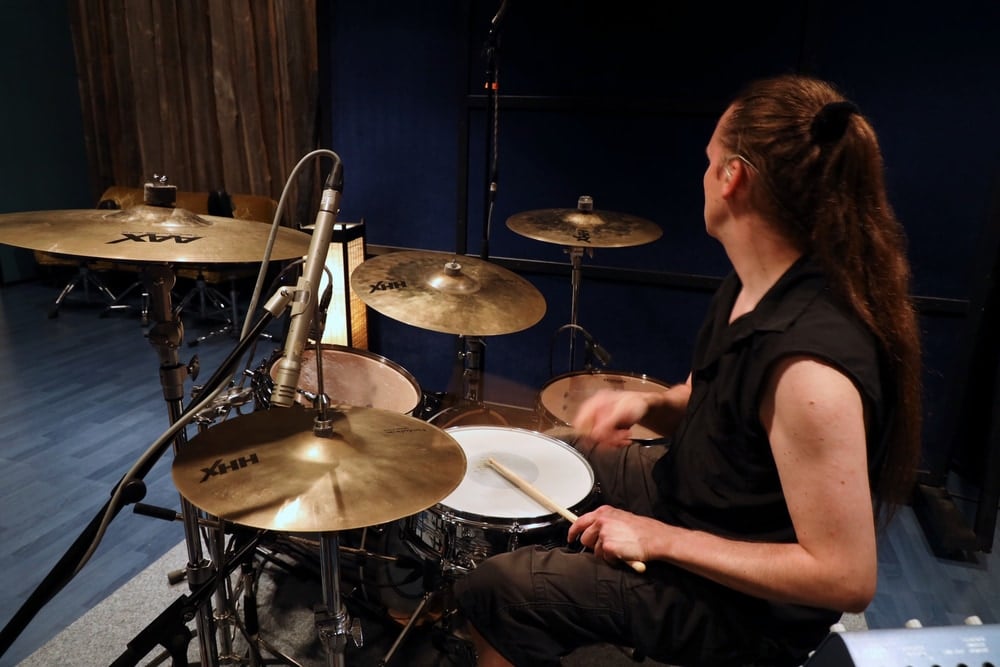Improve The Snare Sound Using This Simple Tip
Does it bother you that your snare is replaced with a sample during mixing? Isn’t your snare cutting through the mix and doesn’t it translate the energy of your hit well enough? This time I want to share with you a tip that I use on every session. Read this post and improve the snare sound using this simple tip.
The drummer and recording engineer will benefit the most by reading this writing.
Improve the snare sound using this simple tip
Let’s get back to my most favourite topic; the drum sound. And the snare sound to be specific. This time either I am not talking about replacing the real sound with samples as I don’t do that. When it comes to all things in life, I prefer the real and genuine. What I mean is how your snare could sound good on the recorded material.
Do you know the feeling when after the drum recording especially the snare sounds like it lacks the energy? Does it often feel like the energy of the snare hit doesn’t translate well enough?
And then sometimes the drums sound good by themselves, but once you add the rest of the instruments the snare simply isn’t cutting through the music. The energy and attack of the snare is what we will be focusing on now.

Fix the source
This time too, it’s good to start with the sound source. And by that I mean how your drums sound acoustically in the recording room. It’s essential that the drums are in good shape and you have tuned them well. “Well” is of course a pretty versatile concept. By that I mean that they should sound acoustically as close to the mixed sound you wish to have your song(s).
The snare is the center of the drum sound. It’s yet to happen that during the session we’d switch to a different bass drum between the songs. Yet, to switch to another snare is quite common and we often do it to fit the song and the mood.
I recall well how back in the 90’s with Children Of Bodom we dreamt of the big 80’s snare sound. Me and Jaska Raatikainen did our best to tune his metal snare as low as possible but the sound just wasn’t right. Dumb as we were we even ended up recording it anyway.
It was only years later when I understood that we were looking for the snare sound from a very wrong starting point. What we needed was a deep wooden snare. Inexperienced as we were, trying to force it out of a small metal snare just didn’t get the result we were looking for.
The snare definitely matters and we often change the snare during the session between songs. It’s not very often that one snare fits every song.

Come on and give me that simple tip asap
When your drum set sounds great acoustically in the recording room and you have both chosen and tuned the snare we finally get to my tip.
When you play rock and metal you should hit the snare using rimshots. I cannot overemphasize the importance of it. When you do it right, the snare sounds like there is a sample involved, but instead of a lifeless sample your snare sounds energetic and alive. It also cuts through the mix pretty nicely.
The rimshot on snare fits especially the heavier music, yet it brings a lot of dynamics and depth to softer playing too. It allows you to accent certain parts bringing in more dynamics.
–Anton Peltola, drummer / Creep Shuttle
When playing the rimshots the angle of the snare is the main factor. Several times I have witnessed how a drummer plays blastbeat using rimshots. This makes each hit sound energetic and solid instead of a dull boxy sound.
It’s important to learn to do the rimshots accurate. If the point where the stick hits varies, so does the sound. Learn to hit the exact same spot. I recommend hitting the snare dead center.
Being relaxed in both the motion and in grip is also important. If you squeeze the stick too much you choke the sound.
–Teemu Minkkilä, drummer / Joku puhuu
You don’t need a large trajectory to have an energetic rimshot. To play solid hits, all it takes is a small hand-movement.
Many drummers ask me to check their drum tuning and once I hit the snare people usually cover their ears. I use a very small hand movement, yet there is a surprising amount of energy. You too can easily learn to do it and the distance your hand moves doesn’t have to be that big.
When playing the drums the dynamics is essential and when playing loud rimshots that’s among the loudest of the scale. If you seek for the loud and energetic snare sound, rimshot is the perfect tool and it should be included in the tool box of every drummer.
–Toni Paananen, session drummer

How the rimshot affects the mix
I have told you before that my best mixing tip for the snare drum is to have the drummer play rimshots during recording. This way the snare will cut through in the mix much more easily and it won’t get buried under the instruments.
The rimshot adds the attack on snare making your playing sound tight. During recording you could tell when the rimshot wasn’t there as the drums sounded more lame and weren’t that solid.
–Anton Peltola, drummer / Creep Shuttle
Sure you can replace the real sound with samples or compress the living spirit out of the snare drum. To me that doesn’t deliver as great a result when compared to the snare that’s played using rimshots.
Rimshots make the snare sound more tight, alive and aggressive and also affect on how the drum room sounds. They work great in the Astia-studio drum room.
–Tommi Tuhkala, drummer / Spell Of Torment
A few drummers have mentioned that in some studios the sound engineer has demanded them not to play the rimshots. If the recording engineer doesn’t want you to play them, I highly recommend you to work with another sound engineer.
When you record your drums in a room that sounds great, the rimshot makes wonders to the room sound as well. It is actually this space that delivers a lot more energy to your drums. And then again a bad sounding recording room can diminish the energy even more.
The rimshot cuts through which on most of the cases will serve the music much better. Dull drums make the whole song sound dull. Rimshot lights up the room sound getting the best out of it – while dull playing wastes a good room. In a great-sounding room snare sounds like it’s already sampled. Strong snare rimshots are used in multiple genres from Big Band-Jazz through Funk to Pop/Rock. That is one of the cornerstones of a great drum set balance.
–Erik T. / Rogue Analogue
Learn from the video below how the rimshot affects the sound. First part is with the close microphones only and without the room. Then the 2nd half is with both the close and room microphones.
Let’s recap the important stuff
When you use rimshots on snare this is how it affects the sound:
- the snare starts to have this “sample”-like energy and firmness
- in the mix the snare cuts through with a lot less effort
- in an awesome sounding drum room the rimshot also improves what the room microphones capture
- your snare sounds as energetic as on many great-sounding albums
If the following happens you need to adjust either the technique or the snare:
- the stick gets worn out where it hits the rim
- you hit the rim only and not the drum head aka missing the hit
- the ringing of the snare is too loud
- the hits sound too different from each other
These factors affect the rimshot and fix the problems listed above:
- adjust the angle of the snare so that it’s easy to play the rimshots
- learn to hit the snare dead center
- if you hit too much to the side the ringing gets too loud
Read more drum-related blog posts from me:
- How To Improve Drum Sound pt. 1
- To Metronome Or Not
- 4 Tips For Drum Recording
- Avoid This Common Mistake When Recording Drums
- The Tempo And How It Should Not Be Chained
- The Beater – Let’s Talk About The Bass Drum Sound
Hit the snare using rimshots
Thank you for letting me help you improve your snare sound. I highly recommend you to learn how to play rimshots on snare. And if you want to do it the cool way, you’ll also learn to play them in a moderate volume.
A rimshot with full force brings a lot of energy and usually makes the room tracks sound awesome. Yet sometimes it can be too much especially when playing a live show in a small venue.
A quiet rimshot adds the energy significantly while keeping the volume down. It all comes down to your motivation and the amount of rehearsing. I believe that you will not only improve how your drums sound, but also how the whole band sounds.
If this post was helpful, please share it on social media. This way you will help your friends to benefit from the information.
To hear your drums recorded in great detail, reserve a full analog tape recording session with me at Astia-studio by clicking here. Thank you very much and all the very best!
Astia-studio is a full analog recording studio located in eastern Finland with 25 years of experience. Bands and artists from all over the world including USA and the furthest corner of Russia, Vladivostok have arrived to us for tape recording sessions.




07/11/2019 @ 12:40 pm
cool! Thanks, Anssi! subscribe to every word!
07/11/2019 @ 1:04 pm
Dear Artem, thank you very much ? Have a great week and all the very best! ?